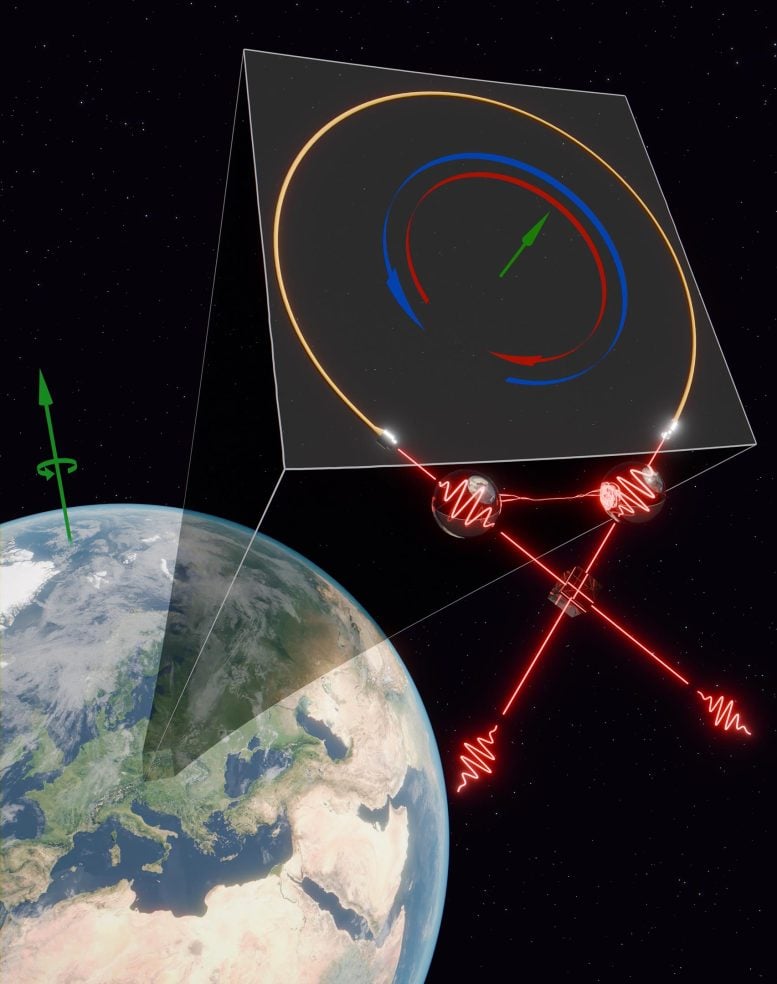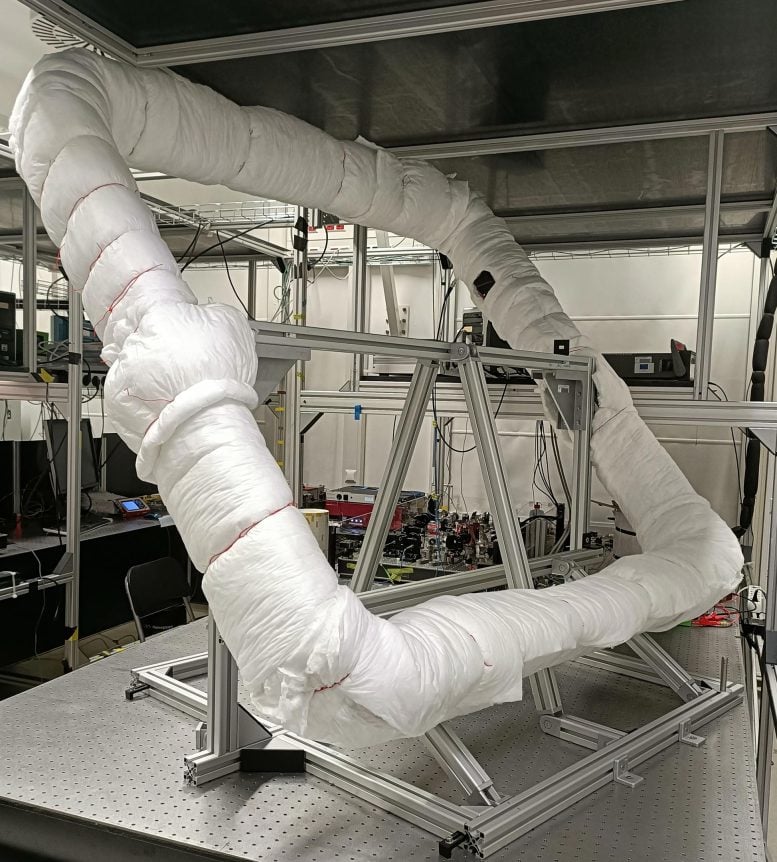
The experiment was photographed drawing a Sagnac interferometric fiber plan inside a magnifying glass from the closest point (Vienna, Austria) to the orbiting Earth. Two indistinguishable images are incident on the beam splitter cube, the density between them is formed, and then they are combined in the fiber interferometer. Credit: Marco Di Vita
A quantum physics experiment at the University of Vienna achieved high precision in measuring the Earth’s rotation using trapped photons.
This research uses an improved Sagnac optical interface that maximizes quantum density to detect spin effects with unprecedented precision, providing potential breakthroughs in quantum mechanics and general relativity.
Quantum Initiation Experiment
The research team conducted the first experiment in which they measured the effect of the Earth’s rotation on the photons trapped in the mass. The work, led by Philip Walther at the University of Vienna, was published on June 14 in the journal Advances in Science. It represents a major breakthrough that pushes the limits of frequency sensitivity in density-based sensors, potentially setting the stage for further exploration at the intersection between quantum mechanics and general relativity.
Developments in Sagnac Interferometers
Optical Sagnac interferometers are the most sensitive devices for rotation. They have been important to our understanding of fundamental physics since the early years of the last century, contributing to the establishment of Einstein’s special theory of relativity. Today, their unparalleled accuracy makes them the ultimate instrument for measuring rotational speed, limited only by the limits of classical physics.

Sagnac interferometer built with 2 km of optical fiber wrapped around a 1.4 meter square aluminum frame. Credit: Raffaele Silvestri
Quantum Encapsulation Increases Sensitivity
Interceptors using quantum density have the potential to break those limits. If two or more particles are trapped, only the overall state is known, while the state of the individual particle remains undetected until measurement. This can be used to get more information per measurement than is possible without it. However, the promised degree of sensitivity jump is limited by the fragile nature of the capture.
This is where the Vienna experiment made the difference. They built a large diameter Sagnac fiber optic and kept noise down and quiet for hours. This enabled adequate detection of high quality captures in the picture Such pairs overcome the accuracy of the rotation of the original quantum optical Sagnac interferometers by a thousand times.
Innovative Techniques in Quantum Measurement
In a Sagnac interferometer, two particles traveling in opposite directions of a closed rotating path reach the starting point at different times. With two trapped particles, it becomes terrifying: it acts like a single particle trying both sides at the same time while accumulating twice the time delay compared to the case where no trap is present. This unique property is known as super-resolution. In an actual experiment, two trapped photons were propagating inside a 2-kilometer-long optical fiber wound on a large coil, detecting an interface with an effective area of more than 700 square meters.
Overcoming Challenges in Quantum Experiments
The biggest obstacle that the researchers faced was isolating and generating stable waves of the Earth’s rotation. “The essence of it,” explains the main author Raffaele Silvestri, “is in finding a place where the light remains unaffected by the rotation of the Earth. Given our inability to stop the spinning of the Earth, we devised a workaround: splitting the optical fiber into two coils of equal length and connecting them through an optical switch.
By turning the switch on and off, the researchers were able to erase the rotating signal at will, which also allowed them to extend the stability of their large device. “Essentially we’ve tricked light into thinking it’s in a non-rotating universe,” says Silvestri.
Proving Quantum Mechanics and Relativistic Interactions
The experiment, which was carried out as part of the TURIS research network organized by the University of Vienna and the Austrian Academy of Sciences, successfully observed the effect of the Earth’s rotation on the situation captured over two images. This confirms the interaction between rotating reference frames and quantum spin, as defined in Einstein’s special theory of relativity and quantum mechanics, with a thousand-fold improvement in accuracy compared to previous experiments.
“That represents an important step since, a century after the first observation of the rotation of the Earth with light, the coherence of individual quanta has finally entered the same conditions of sensitivity,” says Haocun Yu, who worked in this experiment as Marie- Curie. PhD Student.
“I believe our results and methods will lay the foundation for further improvements in the frequency sensitivity of density-based sensors. This may pave the way for future experiments testing the behavior of quantum density through space-time curves,” adds Philip Walther.
Reference: “Experimental investigation of the Earth’s rotation and quantum rotation” by Raffaele Silvestri, Haocun Yu, Teodor Strömberg, Christopher Hilweg, Robert W. Peterson and Philip Walther, 14 June 2024, Advances in Science.
DOI: 10.1126/sciadv.ado0215
#Breaking #Boundaries #Conventional #Physics #Quantum #Density #Measures #Earths #Rotation